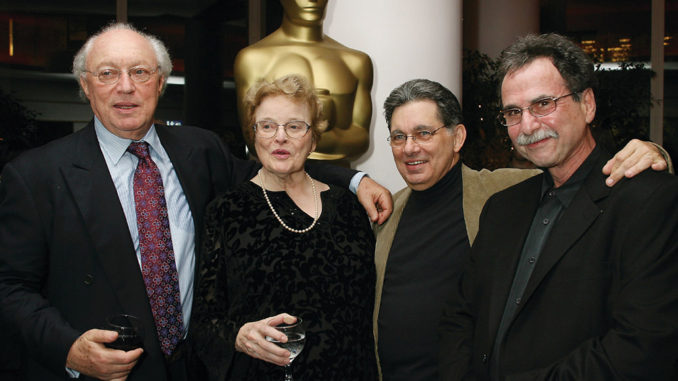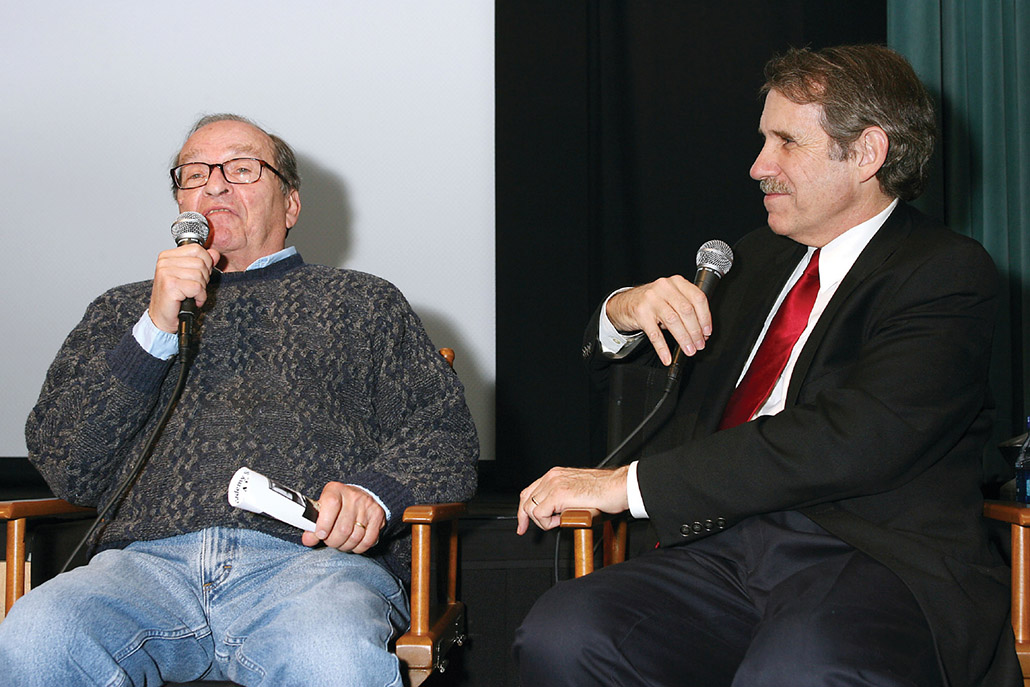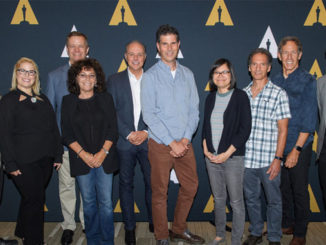
by Adam Wisniewski
As Warren Beatty and Faye Dunaway filled the screen at the Academy Theater at Lighthouse International in midtown Manhattan last fall, they were about to commit their first armed robbery––and they hadn’t even been rightly introduced yet. Of course, those of us gathered in the audience on this early November evening did not need to learn about Bonnie or Clyde, nor did we need an introduction to the guest of honor sitting among us: the film’s editor, Dede Allen, ACE.
Bonnie and Clyde (1967) was Allen’s fourth major film, following Elia Kazan’s America America (1963), Robert Rossen’s The Hustler (1961) and Robert Wise’s Odds Against Tomorrow (1959), although the evening’s host, Rolling Stone film critic Peter Travers, was quick to point out the omission of Terror From the Year 5000 (1958) from the program. “When you look at Dede Allen’s movies, whether it’s a big battle or a close-up, there is a rhythm and music to the scene,” Travers added. “And there’s no way to know how she does it.”
Allen began her career as a sound editor in Hollywood in 1943 before moving to New York in 1950, where she studied directing while working in sound in live theatre. Although she never ended up behind the camera, she noted that it wasn’t her directorial training that prepared her to cut film. “Whatever people call your ‘rhythm’ as an editor is affected by a gut feeling and a sense of timing,” Allen explained. “Most of it, for me, came from sound.”
Travers was at center stage throughout the evening introducing film clips, guest speakers and occasionally posing questions regarding Allen’s remarkable career, which includes a wide variety of films from the last five decades, among them Slaughterhouse Five (1972), The Breakfast Club (1985) and Wonder Boys (2000). After screening more clips from Odds Against Tomorrow, The Hustler, and Bonnie and Clyde, Travers presented two of her colleagues from the latter film.
“Dede is the only great editor I’ve ever worked with.” – Sidney Lumet
Actress Estelle Parsons, an Oscar winner for Best Supporting Actress as Blanche Barrow, recalled Allen’s role in her own success with an anecdote about Marlene Dietrich. While once attending a Dietrich film festival, Parsons formed an opinion that in some movies Dietrich was clearly a star, while in others, it seemed as if any other popular actress could have played her role. She learned in a discussion with a friend that in the films she liked, the editor would extend Dietrich’s close-ups by a few extra frames––and that difference made her into the star we know today.
She also noted that although all of Bonnie and Clyde’s major actors were nominated for Academy Awards, she was the only one to win. “And for that,” she said to Allen, “I’d like to thank you for the few extra frames that made my life so much fun.”
With its brutal and choreographed violence, kinetic cuts and famous closing montage, Bonnie and Clyde redefined American cinema and begat a long working relationship between Allen and director Arthur Penn, which included Alice’s Restaurant (1969), Little Big Man (1970) and Night Moves (1975). Penn said he had invited Allen to visit his sets so that she might understand the physicality of the scenes and feel the actors’ presence in them. “The first cut of every film is like a suicide note––no rhythm, flaccid and excessive,” stated Penn. “Slowly, a film is infused with rhythm that’s not visible to most audiences.”
A clip from Alice’s Restaurant illustrated the particular challenge Penn and Allen faced trying to sync the visuals to Arlo Guthrie’s song, despite the fact that there was no music on the set. Penn related that he enjoyed their collaborations because Allen was “relentless” in the editing room. “Her sensibility to actors is remarkable,” he explained. “Dede would find the moment I wouldn’t see. She finds the capability to change that moment with a pearl of wisdom that you didn’t think was there.”

From hails of gunfire and Massachusetts litterbugs to cries of “Attica! Attica!” Travers then introduced a clip that was a little closer to home for the audience, Al Pacino’s famous crowd scene from Sidney Lumet’s Dog Day Afternoon (1975). Lumet spent several minutes discussing politics in his films Dog Day and Serpico (1973), both of which Allen edited. Serpico’s production schedule went at breakneck speed, and Lumet had Allen cutting the film as he was shooting it.
“Serpico took five months and one day from shooting to release,” said Lumet. “I saw the first cut two days after shooting. Dede had not only realized the intention of the movie as a whole, she had realized all of my intentions as a director. She gave me not only what I wanted, but better than I could have done myself.” Lumet acknowledged that he enjoyed working with Allen because she serves her material––from the director to the actors to the soundman. “She is the only great editor I’ve ever worked with,” he stated simply.
At the turn of the 1980s, who would have thought that Dede Allen would be spending all of her time at Studio 54? Craig McKay, Allen’s co-editor on Warren Beatty’s Reds (1981), opened his comments by stating, “We spent almost two years cutting it at 54th Street, right above Studio 54, working six or seven days a week.” McKay had an affinity for white chocolate, and he would send the apprentice out to the Korean deli for bars of the good stuff. Allen discovered his secret and from then on, every trying moment led to runs for sheets of white chocolate. “It was one of my greatest editorial experiences,” McKay said of working on Reds. “We had a relationship that was nonverbal. The thing I learned from Dede was how to be a general––because practically the entire New York production community worked on the film.”

The prominent sound mixer Tom Fleischman took the stage next, and no one in the room owed more to Allen than him; he is her son. When he was 10, his mother took him to the set of The Hustler, he recalled. In high school, he spent summers logging film. When he decided he wanted to break into Hollywood, she offered to make a phone call for him but told him that the rest would be up to him. “I remember at 15, she taught me to reconstitute trims,” Fleischman said. “Looking at film and holding it really got me. Young people don’t get to do that anymore.”
Ironically, Fleischman ended up as a respected professional in the same area of filmmaking that Allen left. “She thought sound editing was boring––going over the same piece of film over and over,” he related. “I, on the other hand, found it interesting.” Now 25 years into his own career, the son celebrated his mother’s influence, saying, “Thank you for introducing me to this wonderful business.”
While many of the evening’s speakers were Allen’s peers or co-workers, Richard Marks, ACE, offered the unique perspective of having been Allen’s assistant, associate and co-editor. As her “mentee,” Marks said that she taught him how to define the story he was trying to tell. “Dede gave editors the right to call themselves ‘collaborators’ in the filmmaking process,” he claimed, adding that she had impacted three generations of film editors.
Finally, to thunderous applause and a standing ovation, Allen took the stage. She recalled some details of her mobile life as a child, but was emphatic in saying, “New York is the place I did all my work and the place I love the most.” She fondly remembered the golden era in New York when artists came here to make pictures. Allen concluded by thanking those in attendance––as well as Robert Wise and Elia Kazan for offering her early chances to edit.
And what of the forgotten Terror in the Year 5000? “A piece of junk,” she said with a laugh.





